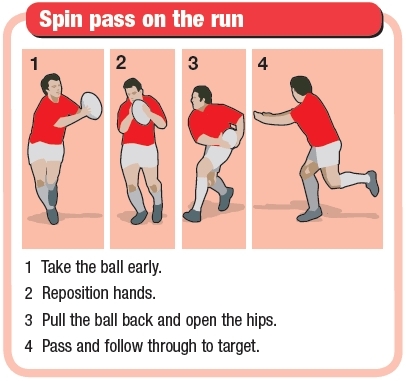Throwing a rugby ball well is essential for success in the game. It improves team coordination and helps in making accurate passes.
Learning how to throw a rugby ball correctly can be challenging but rewarding. It’s a skill that can elevate your game by enhancing your passing accuracy and speed. Whether you are a beginner or looking to refine your technique, understanding the basics of a proper throw is crucial.
This guide will walk you through the essential steps and tips to help you throw a rugby ball with confidence and precision. Get ready to improve your skills and enjoy the game even more!

Credit: www.rugbycoachweekly.net
Choosing The Right Ball
Choosing the right rugby ball is essential for throwing accurately and effectively. The ball’s size, weight, material, and grip can impact your throw. Let’s explore the key factors to consider.
Size And Weight
Rugby balls come in different sizes and weights. Select the correct size for your age and skill level. Here’s a quick guide:
| Age Group | Ball Size |
|---|---|
| Under 9 | Size 3 |
| 9-14 Years | Size 4 |
| 15 and Above | Size 5 |
The weight of the ball also matters. A heavier ball can be harder to throw. A lighter ball might not travel far. Choose a balance that suits your strength and skill.
Material And Grip
The material of the ball affects how you throw it. Rugby balls are typically made from synthetic leather or rubber. Synthetic leather balls are durable and provide a good grip. Rubber balls are more affordable but might not offer the same grip.
Grip is crucial for throwing accuracy. Look for balls with textured surfaces. This helps you maintain control. A good grip can make a big difference, especially in wet conditions.
Test different balls to find the best fit for you. Your comfort and control are key. The right ball can improve your throw significantly.

Credit: www.wikihow.com
Basic Rugby Throwing Rules
Understanding the basic rugby throwing rules is essential for all players. These rules ensure fair play and maintain the game’s flow. Two critical aspects are the prohibition of forward passes and the proper execution of lineout throws.
Forward Pass Prohibition
In rugby, the ball must not be passed forward. The ball can only be thrown sideways or backward. A forward pass results in a turnover to the other team. This rule keeps the game fair and competitive.
Lineout Throws
A lineout occurs when the ball goes out of bounds. The team that did not touch the ball last gets to throw it back in. The throw must be straight down the middle of the lineout. Both teams will have players jumping to catch or tap the ball. Proper lineout throws are crucial for maintaining possession.
Grip And Hand Placement
Learning to throw a rugby ball starts with the correct grip and hand placement. A good grip ensures accuracy and power. Proper hand placement helps in controlling the ball’s direction.
Finger Positioning
Spread your fingers across the seams of the ball. Your index finger should be close to the end of the ball. Place your middle and ring fingers along the seams. The pinky finger should rest on the opposite seam. This positioning offers better control and stability.
Thumb Alignment
Align your thumb along the bottom seam of the ball. The thumb should point towards the ball’s tip. This alignment provides a firm grip. It also helps in guiding the ball during the throw.
Stance And Body Position
Understanding the proper stance and body position is crucial for throwing a rugby ball effectively. Your stance provides the foundation for a strong and accurate throw. It helps you maintain balance and control. Let’s break down the key components of stance and body position.
Feet Placement
Start with your feet shoulder-width apart. This gives you stability. Your lead foot should point towards your target. The back foot should be slightly turned out. This positioning helps you generate power. Shift your weight to the balls of your feet. This ensures you are ready to move.
Knee Bending
Bend your knees slightly. This helps you stay balanced. It also allows for a quick pivot. Flexed knees provide the necessary spring. They help in generating force. Keep your knees aligned with your feet. This reduces the risk of injury. It also ensures an efficient transfer of energy.
Arm Motion And Release
Throwing a rugby ball with precision involves mastering the arm motion and release. This skill is crucial for delivering accurate passes and maintaining the flow of the game. Let’s break down the key components of the arm motion and release, focusing on the wind-up technique and the follow-through.
Wind-up Technique
The wind-up sets the stage for a successful pass. Start with the ball held firmly in both hands. Ensure your fingers are spread across the seams for better grip.
- Stand with your feet shoulder-width apart.
- Rotate your upper body slightly towards the target.
- Bring the ball back to your hip, keeping your elbows bent.
This positioning ensures you generate enough power for the throw. Keep your eyes focused on your target to enhance accuracy.
Follow-through
The follow-through is as important as the wind-up. It ensures the ball reaches its intended target with precision.
- Extend your arm towards the target as you release the ball.
- Snap your wrist to impart a spiral motion on the ball.
- Finish with your arm pointing towards the target.
Proper follow-through helps in maintaining the direction and speed of the ball. Practice these steps to enhance your passing skills.

Credit: www.wikihow.com
Throwing For Distance
Throwing for distance in rugby requires skill and practice. It’s not only about strength but also technique. Mastering this can improve your game significantly.
Generating Power
Generating power is crucial for distance. Start with a strong grip on the ball. Place your dominant hand on the back and your other hand on the side. Use your fingers to control the ball. Stand with your feet shoulder-width apart. Bend your knees slightly. This stance provides balance and power.
Rotate your torso as you prepare to throw. Use your core muscles to generate force. Keep your arm straight and release the ball with a snap of your wrist. Practice this motion to build strength and accuracy.
Maintaining Accuracy
Maintaining accuracy is as important as power. Focus on your target before throwing. Keep your eyes on the spot where you want the ball to go. This helps in aiming.
Follow through with your throwing arm. This ensures the ball travels in the desired direction. Practice regularly to improve both power and accuracy. Consistency is key. The more you practice, the better your throw will become.
Throwing For Accuracy
Throwing a rugby ball with accuracy is crucial for game success. Accurate throws ensure the ball reaches the intended teammate. This skill requires practice and understanding various factors. Let’s explore some key aspects to improve your throwing accuracy.
Target Practice
Practicing with a target helps improve accuracy. Set up a target, like a cone or a net, at different distances. Aim for the target consistently to build muscle memory. Start with shorter distances and gradually increase as you get better. Focus on your form and release each time.
Adjusting For Wind
Wind can affect the trajectory of your throw. Pay attention to the wind direction before throwing. Adjust your aim slightly to compensate for the wind’s effect. If the wind is strong, throw with more force to counteract it. Practice in different wind conditions to become adaptable.
Common Mistakes To Avoid
Throwing a rugby ball might seem easy, but many players make common mistakes. These mistakes can affect your throw’s accuracy and distance. By understanding what to avoid, you can improve your skills and performance.
Incorrect Grip
One common mistake is holding the ball incorrectly. A bad grip can affect control and precision. To grip the ball correctly, place your fingers along the seams. This helps you guide the ball better. Avoid holding the ball too tightly. A relaxed grip allows for a smoother throw.
Poor Stance
Your stance is crucial in rugby. A poor stance can lead to weak throws. Stand with your feet shoulder-width apart. This gives you balance and stability. Bend your knees slightly to keep your body flexible. Make sure your weight is on the balls of your feet. This helps you react quickly and throw with power.
Advanced Throwing Techniques
Mastering the basics of throwing a rugby ball is essential. Once you have the basics down, you can move on to advanced techniques. These techniques enhance your gameplay and make you a more versatile player.
Spin Pass
The spin pass is a powerful tool in rugby. It allows the ball to travel further and with more accuracy. Here’s how to perform a spin pass:
- Hold the ball with both hands, fingers spread wide.
- Rotate your wrists to generate spin.
- Step forward with your non-dominant foot.
- Release the ball, ensuring your hands follow through.
Practice is key. The more you practice, the better your spin pass will become.
Pop Pass
A pop pass is quick and short. It’s used in tight situations. Here’s how to execute a pop pass:
- Hold the ball close to your body.
- Use your wrists to flick the ball to a teammate.
- Ensure the pass is short and quick.
This pass is useful in fast-paced situations. It helps maintain the flow of the game.
| Technique | Key Points |
|---|---|
| Spin Pass | Long distance, accuracy, spin, follow-through |
| Pop Pass | Short distance, quick, wrist flick, close to body |
Both techniques are essential. They each serve different purposes. Mastering both will make you a better player.
Training Drills And Exercises
Training drills and exercises are essential for mastering how to throw a rugby ball. Regular practice helps improve accuracy, strength, and consistency. Here, we will discuss two effective training methods: solo practice and partner drills.
Solo Practice
Practicing alone allows you to focus on your technique without distractions. Here are some drills you can do on your own:
- Wall Passing: Stand a few meters from a wall. Throw the ball against the wall and catch it on the rebound. Repeat to improve accuracy and strength.
- Target Practice: Place targets on the wall at different heights and distances. Aim to hit each target with your throws.
- Footwork Drills: Practice moving your feet as you throw the ball. This helps in developing coordination and balance.
Consistency is key in solo practice. The more you practice, the better you get.
Partner Drills
Practicing with a partner helps simulate real game situations. Here are some effective partner drills:
- Passing Back and Forth: Stand a few meters apart. Throw the ball back and forth, focusing on accurate passes.
- Running Passes: Run side by side with your partner. Pass the ball while on the move to mimic game scenarios.
- Defensive Drills: Have your partner act as a defender. Practice passing the ball around them to improve your agility and decision-making.
Communication is crucial in partner drills. Always maintain eye contact and call out before passing.
Frequently Asked Questions
How Do You Properly Grip A Rugby Ball?
To properly grip a rugby ball, place your fingers along the seams. Ensure your fingers are spread out for better control. Your thumbs should rest on the underside of the ball.
What Is The Best Technique For Passing A Rugby Ball?
The best technique is to use both hands. Swing your arms across your body and follow through with your wrists. This generates a spiral pass.
How Can I Improve My Rugby Ball Accuracy?
To improve accuracy, practice regularly. Focus on your grip and follow-through. Always aim for a consistent spiral pass.
What Drills Help With Rugby Ball Throwing?
Drills like partner passing, wall throws, and target practice are effective. These drills enhance accuracy, grip, and arm strength.
Conclusion
Throwing a rugby ball well takes practice and patience. Start with proper grip. Focus on your target. Keep your eyes on the ball. Practice regularly to improve. Enjoy the process and stay consistent. With time, you will see progress. Share these tips with friends.
Enjoy playing rugby and have fun.


